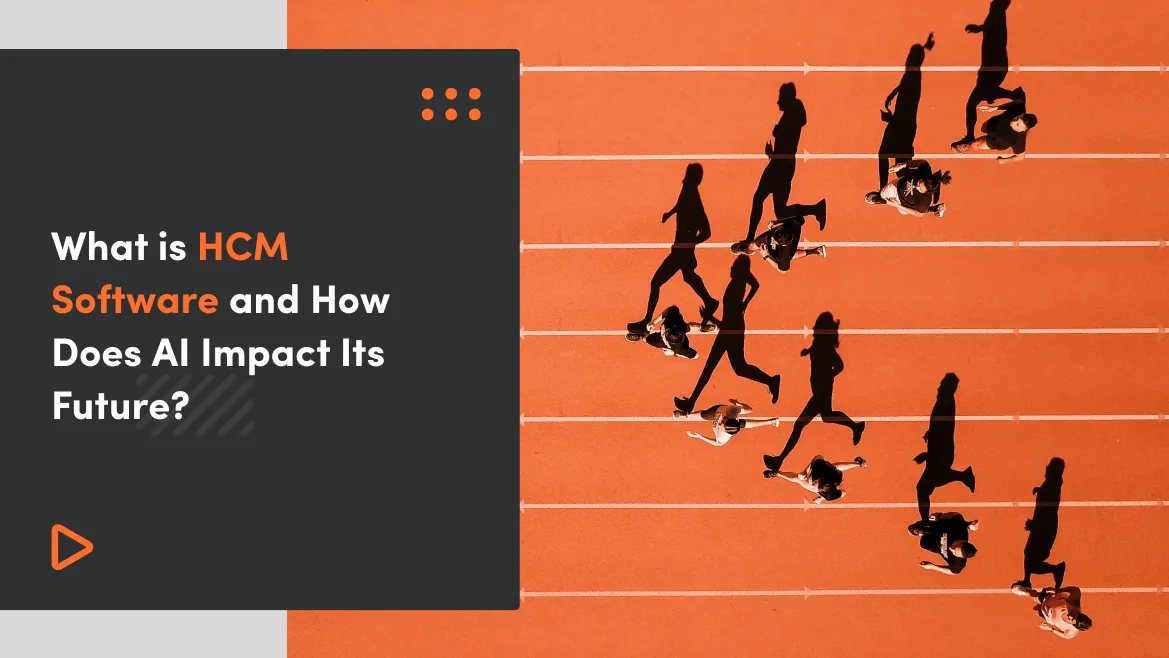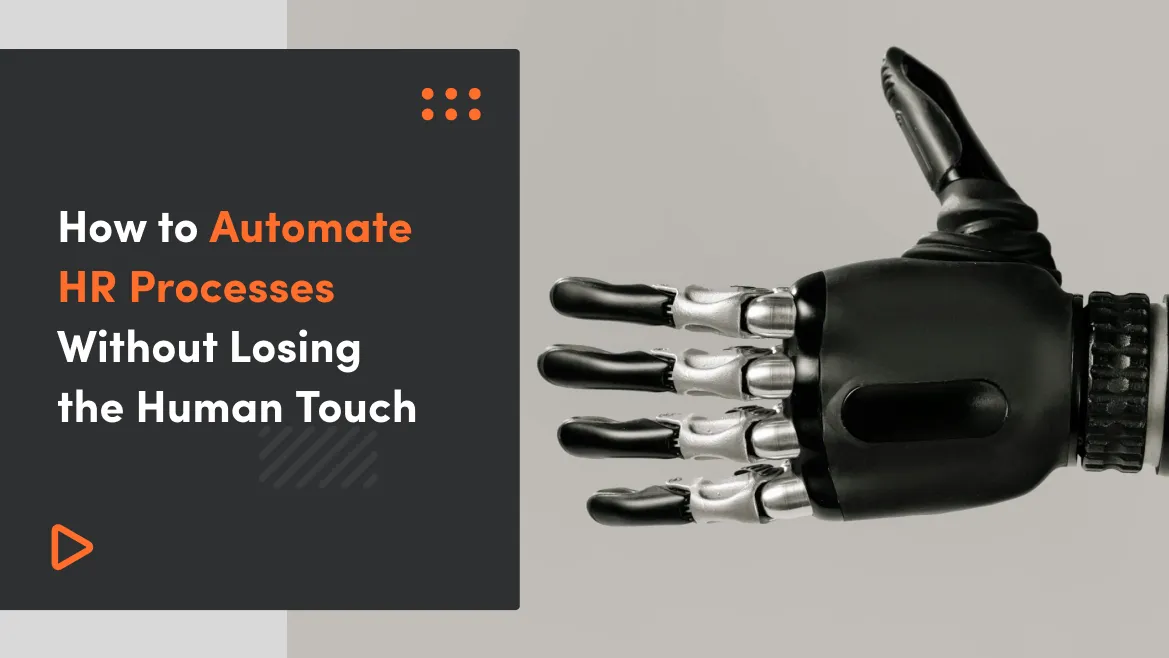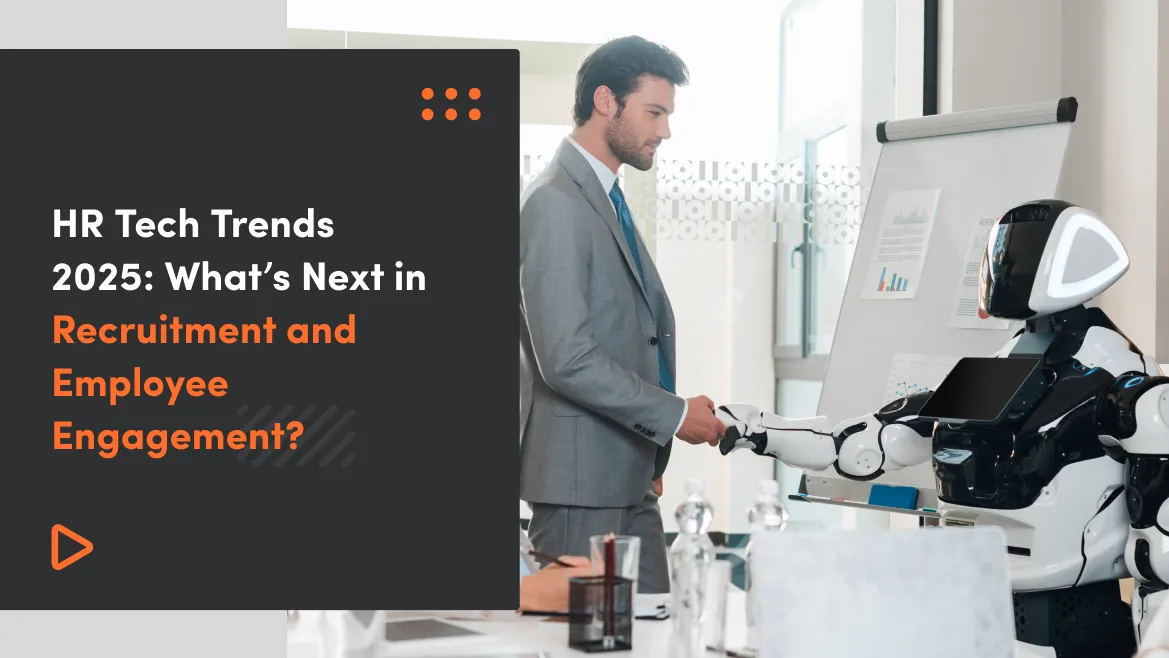Human Capital Management (HCM) software is an essential tool for business as it effortlessly integrates HR operations and provides effective workforce management.
What is Human Capital Management? HCM is a set of modern IT applications and technologies used to implement HR operations. It encompasses traditional workforce management functions, such as hiring, job and position management, HR compliance, and reporting. By automating these procedures, human resources can shift their emphasis from administrative duties to strategic initiatives, resulting in increased productivity and better overall operations.
HCM software is not complete without Artificial Intelligence (AI). AI in HCM software provides deep insights into worker's performance, which also forecasts attrition rates and expedites the hiring process by identifying the best applicants.
For example, IBM has improved employee retention by predicting 95% of its turnover using a “predictive attrition program,” developed through its artificial intelligence (AI) platform.
Similar to this, LinkedIn uses AI to offer customized instruction suggestions, which has increased employee participation in training initiatives. This technology integration maximizes resource allocation while also enhancing decision-making. According to Gartner, companies that integrate AI into their HCM system reported a decrease in the amount of time spent on administrative duties and workforce management. AI's contribution to HCM software will only increase as it develops further, providing even more opportunities to raise output and improve worker satisfaction.
These instances show how cutting-edge businesses are utilizing AI and Human Capital Management software to enhance operational efficiency and preserve a competitive advantage in their spheres of influence.
In this article you will learn:
- What is an HCM Software Solution?
- How does the HCM system help in talent management?
- What are the functions of Human Capital Management Software?
- How does AI drive recruitment and talent management functions in HCM software?
- How does AI drive personalized learning and development programs in HCM software?
- How does the HCM system benefit administration by reducing the time to perform HR operations?
- What is Predictive Analytics (Human Resources Analytics) used in HCM systems?
- How to achieve automation and efficiency by integrating AI into HCM software?
- How AI in HCM software will impact the future of businesses?
-
HCM software is a set of technologies to perform HR professionals' tasks and help in employee management
-
Integrating HCM software with AI increases efficiency by automating HR operations and giving useful insights.
-
Companies like IBM utilize AI to evaluate employee data increase in employee retention via real-time feedback and individualized growth plans.
-
AI delivers deep insights and predictive analytics, allowing organizations to minimize turnover by identifying at-risk employees early on and implementing proactive retention tactics.
-
AI automates repetitive HR operations, decreasing administrative strain and freeing up HR personnel to focus on strategic initiatives.
-
AI-driven insights enable educated decision-making, hence increasing overall HR strategies and outcomes.
-
Predictive analytics helps to assure labor law compliance, lowering the chance of legal difficulties and penalties.
-
AI solutions offer customized input and growth possibilities, increasing employee motivation and productivity.
-
Businesses that use AI in human capital management have a competitive advantage in managing their staff efficiently and effectively.
What Are the Functions of Human Capital Management Software?
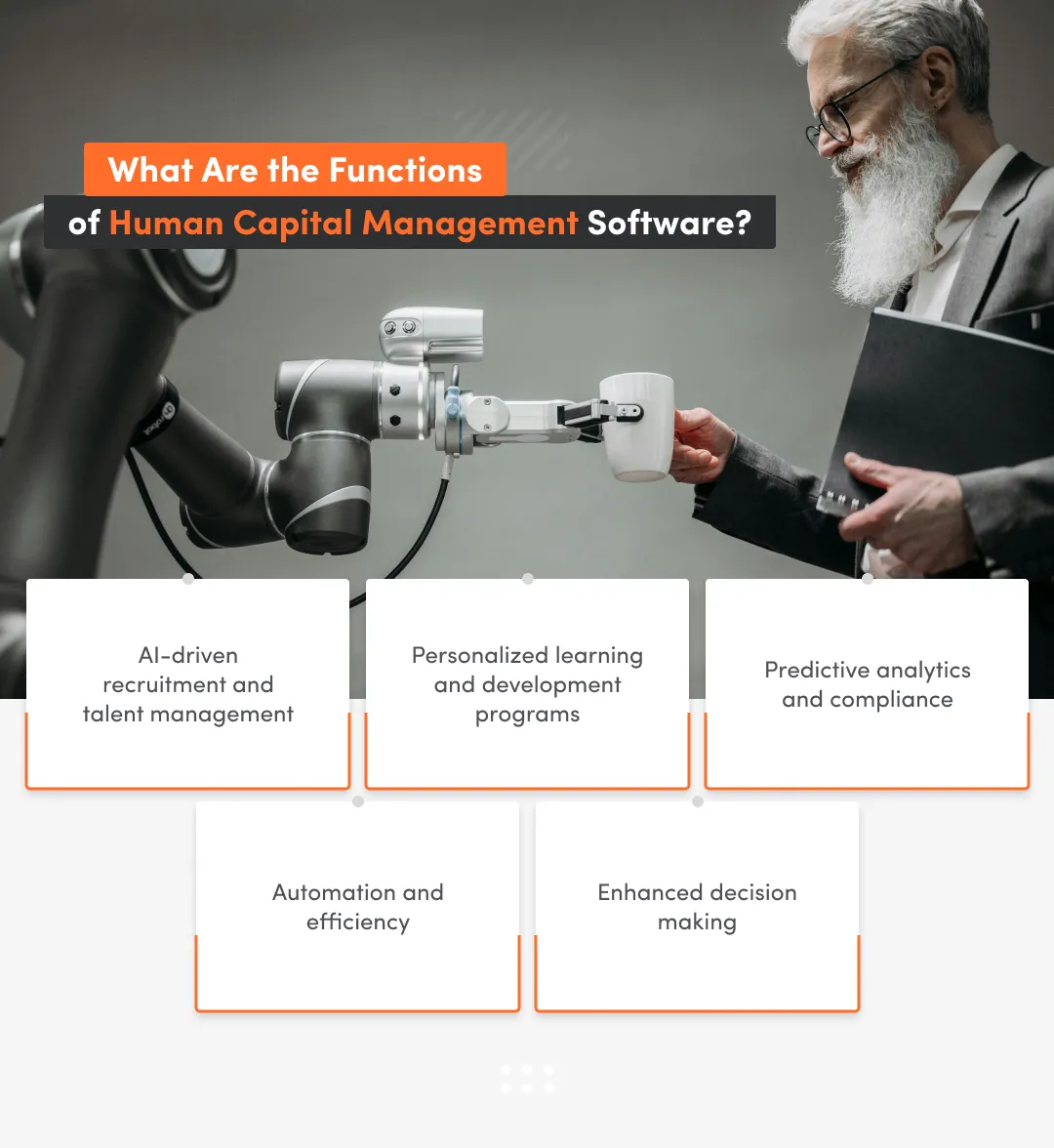
Human Capital Management software helps companies in workforce management by combining several tasks into a single platform. To answer, what is HCM software and how it functions, listed below are a few of the main features:
AI-Driven Recruitment and Talent Management (automation)
Leveraging AI-driven recruitment and talent management solutions can revolutionize the hiring process, enhancing efficiency and precision. Automation streamlines candidate selection, ensuring the best talent aligns with organizational needs.
- Automated Screening: Using artificial intelligence (AI), automated screening rapidly evaluates applications and resumes to identify the top applicants based on predetermined standards. To select candidates, you can use AI-driven evaluations and algorithmically analyzed video interviews. This strategy reduced the amount of time needed to screen applicants without compromising on the quality of talent. This procedure improves the impartiality and accuracy of candidate selection while drastically cutting down on the amount of time needed for preliminary screenings.
- Talent Acquisition and Onboarding: Artificial intelligence (AI) expedites the hiring and onboarding of new employees by automating tedious processes like arranging interviews and sending follow-up emails. It helps automated interview scheduling with AI, cutting the hiring process's duration. This allows HR specialists to concentrate on more important tasks, guaranteeing new hires a more seamless and effective onboarding process.
- Employee Engagement: AI solutions improve worker engagement by tracking performance and offering individualized feedback. Companies like LinkedIn have seen a boost in employee engagement with training programs as a result of using AI to suggest customized learning courses to its staff. Additionally, by offering customized growth possibilities, these tools support your staff members' career advancement and motivation, all of which increase output and satisfaction levels.
Personalized Learning and Development Programs (training and development)
Personalized learning and development programs driven by AI are revolutionizing the way workers grow in their professions and learn new skills. AI is improving training and development in the following ways:
Adaptive Learning: AI-powered adaptive learning adapts course material to each student's unique learning preferences and speed. PwC employs AI-driven platforms to design customized educational routes for staff members, improving the application and retention of information. This guarantees that every worker gets training that works best for them.
Skill Gap Analysis: AI plays a crucial role in skill gap analysis, evaluating an individual's current competencies and identifying areas for improvement. Amazon leverages AI to identify skill gaps in its workforce and design targeted training programs, resulting in a more knowledgeable and skilled workforce.This accurate assessment is instrumental in creating training plans that address specific areas of need, highlighting the key role of AI in this process.
Training and Career Development: AI helps with training and career development by making course and resource recommendations based on each person's unique career objectives and skill gaps. Businesses use AI to give its workers individualized career development plans, which increases worker retention and satisfaction. This individualized approach not only promotes employee development but also synchronizes it with the organization's strategic goals.

Predictive Analytics (HR analytics) and compliance
AI helps in predictive analytics empowering your business to take control of workforce management and compliance. Here's a look at its key applications:
Workforce Planning: Predictive analytics, by analyzing recent and past employee data, will help you forecast workforce needs. It helps you in forecasting labor demand and optimizes staff planning using predictive analytics, which improves operational efficiency. This proactive approach ensures that your business is prepared to handle changes in demand, giving a sense of control.
Employee Retention: You can employ predictive models to identify employees who are likely to leave and implement retention efforts. IBM has identified at-risk workers using predictive analytics, and by implementing interventions, retention rates have increased by 25%. This early intervention aids in keeping top talent and lowering turnover rates.
Analytics: Extensive HR analytics offer valuable perspectives on a range of HR indicators, including worker productivity, engagement, and contentment. Microsoft analyzes employee data using HR analytics, which has improved overall HR strategy and results. Businesses can employ these insights to make data-driven choices.
Compliance: Predictive analytics assists you in monitoring adherence to labor rules and regulations by detecting possible hazards and regions of non-compliance. You can employ predictive analytics to ensure labor laws are followed, which lowers the possibility of fines and legal problems and guarantees that companies respect the law.
Automation and Efficiency
By utilizing current technologies, HR operations can automate and efficiently handle talent management. Task automation and AI-powered solutions help you in the following ways:
- Task Automation: Task automation streamlines time-consuming and repetitive HR processes like employee data input, scheduling, and payroll processing. SAP SuccessFactors automates payroll processing, for instance, lowering mistakes and saving time. By automating these responsibilities, you can free up your HR personnel to work on more strategic objectives.
- Chatbots and Virtual Assistants: Chatbots and virtual assistants, another aspect of current HR management technologies, play a crucial role in effectively enhancing employee management. They provide instant responses to frequently asked HR-related questions and assist with activities like benefit enrollment and leave requests.
For example, Accenture uses AI-powered chatbots to manage staff inquiries, improving response times and employee satisfaction. These solutions significantly enhance employee satisfaction and reaction times, thereby contributing to a positive work environment.
Enhanced Decision Making
Data-driven insights greatly help in facilitating your business with enhanced decision-making in HR management.
- Data-Driven Insights: Data-driven insights, a cornerstone of current HR technologies, play a pivotal role in facilitating enhanced decision-making. HR professionals can make well-informed decisions based on precise and up-to-date information.
For instance, Google uses data-driven insights to analyze patterns in employee performance and engagement, leading to focused improvement plans. By scrutinizing trends and patterns in employee performance, engagement, and attrition, enterprises can identify opportunities for enhancement and execute focused tactics. This strategy ensures that decisions are backed by strong evidence, thereby improving operational efficiency and benefiting the company.
How AI in HCM Will Impact the Future of Human Capital Management
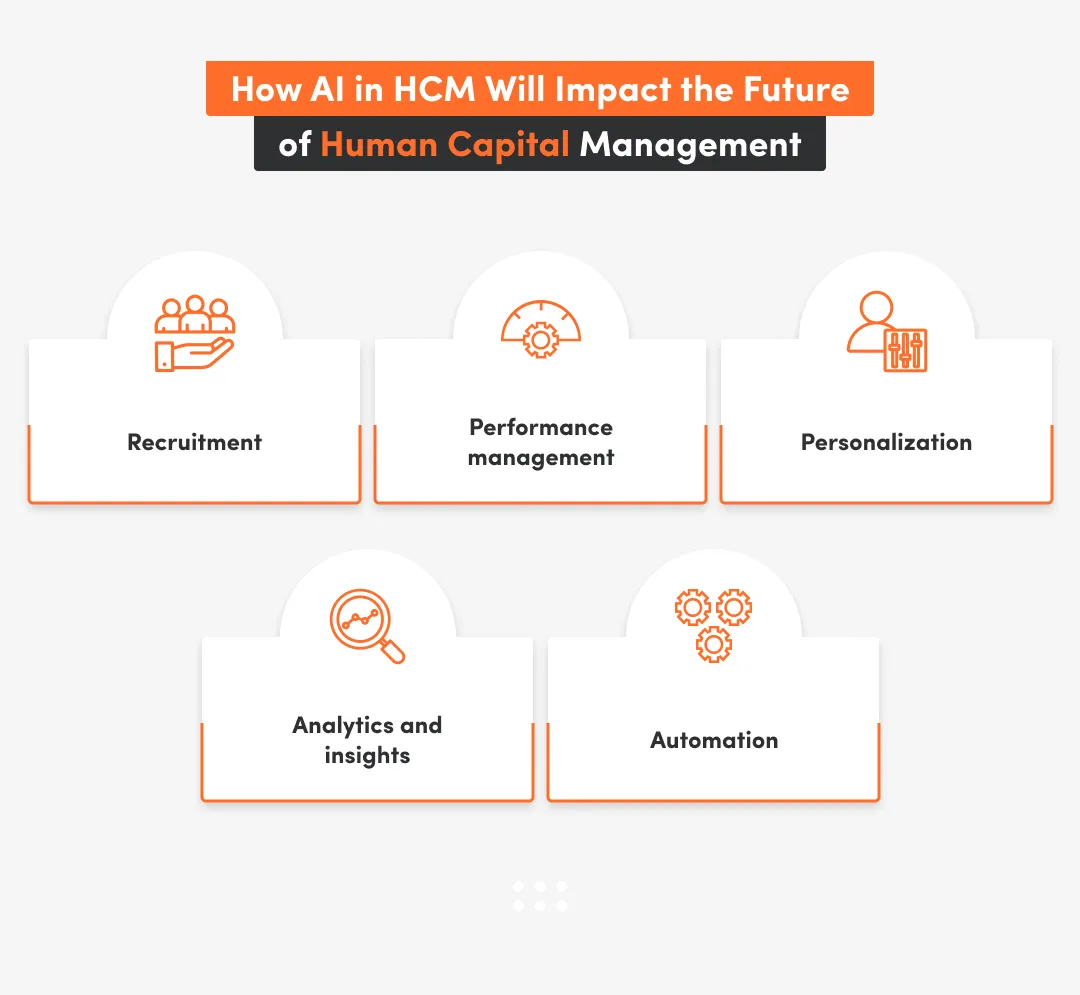
Artificial Intelligence (AI) and Human Capital Management (HCM) software integration could significantly boost your company's output and effectiveness. Using this cutting-edge technology as a CEO or decision-maker can not only help you expedite your HR procedures but also give you important information for making strategic HR management decisions. Here are some ways AI in HCM system could impact important facets of your company:
Recruitment
AI will transform recruiting by eliminating prejudice in the hiring process, expediting the identification of the best candidates, and automating preliminary screenings.
For example, Unilever used artificial intelligence (AI) in their hiring process, shortlisting candidates using AI-driven tests and algorithm-analyzed video interviews. This strategy reduced the amount of time needed to screen applicants by 70% without sacrificing the quality of hires. By concentrating just on a candidate's credentials and performance, AI technologies facilitated a diverse and inclusive recruiting process by removing unconscious prejudice.
Performance Management
AI in performance management gives managers data-driven insights and real-time feedback, allowing them to make informed decisions regarding the growth and performance of their workforce. IBM uses AI to evaluate employee data, including project completion rates, peer reviews, and customer feedback, to forecast performance in the future and pinpoint areas that require development.
AI promotes a high-performance and continuous improvement culture by offering ongoing feedback and customized growth plans.
Personalization
By customizing career development pathways and training programs to each employee's requirements and objectives, AI improves customization in HRM. For instance, LinkedIn employs AI to suggest customized learning programs to its staff members according to their skill levels, job responsibilities, and career goals. Employee participation in training programs increased by 58% as a result. Employee satisfaction and retention are raised by these specialized development opportunities, which guarantee that staff members are always learning and developing.
Analytics and Insights
AI provides sophisticated analytics and insights that enable human resources to see possible problems, forecast trends, and decide on the best course of action. General Electric (GE) analyzes performance indicators, attrition rates, and employee engagement surveys using AI-driven data. By identifying at-risk employees early and putting retention initiatives in place, this predictive analysis has assisted GE in reducing the turnover rate. By being proactive and optimizing staff management and planning, these insights help firms.
Automation
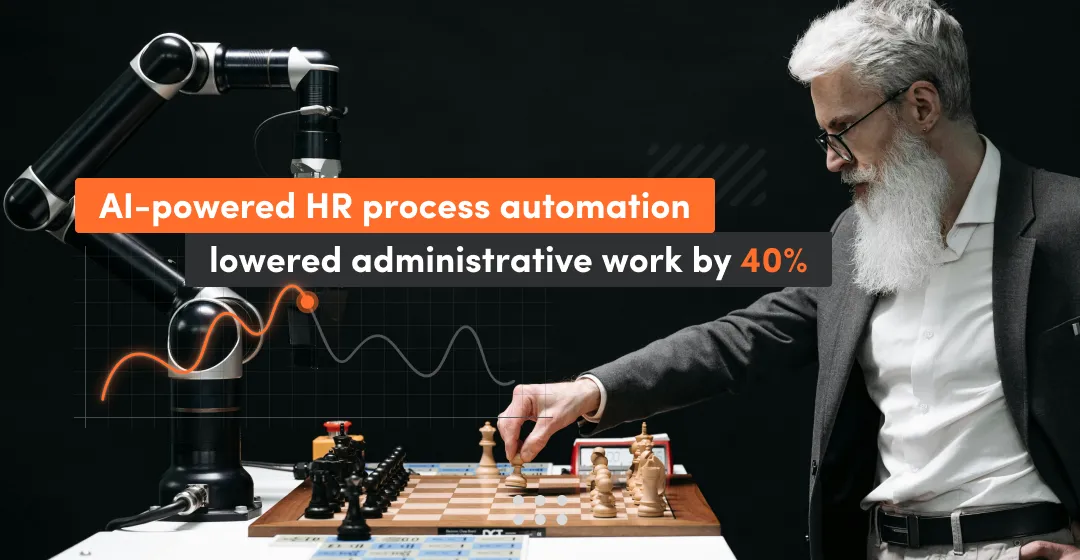
AI-powered automation simplifies a range of HR functions, including payroll processing and onboarding, freeing up HR staff members to concentrate on key projects.
According to a Deloitte case study, AI-powered HR process automation lowered administrative work by 40%, freeing up HR staff to concentrate more on strategic endeavors. AI-driven chatbots, for instance, can react to workers' questions about benefits, leave balances, and corporate policies, lightening the burden for HR personnel and giving workers immediate assistance.
AI can be integrated with HCM software to completely revolutionize and improve your HR processes. This connection gives you a competitive edge in managing your most precious asset, which is your people, in addition to increasing productivity.
Try our developers.
Free for 2 weeks.
No risk. Just results. Get a feel for our process, speed, and quality — work with our developers for a trial sprint and see why global companies choose Selleo.
Summary
For modern companies, integrating artificial intelligence (AI) with human capital management (HCM) software has significant advantages. HR workers can concentrate on strategic efforts instead of administrative activities by using HCM software to automate critical HR processes, including payroll, training, performance management, and recruiting.
AI strengthens these capacities by offering individualized insights and real-time data, which facilitate better decision-making and efficient resource allocation. For instance, businesses like IBM and Unilever have effectively incorporated artificial intelligence (AI) into their performance management and hiring processes, respectively, leading to notable gains in productivity and staff retention.
The effects of AI on HCM are felt in many facets of workforce management. AI-driven solutions in recruiting provide a high-quality and diverse candidate pool by automating preliminary screenings and minimizing prejudice. Artificial intelligence (AI) helps performance management by providing real-time data and feedback, which promotes a culture of continuous development.
Artificial intelligence (AI)-driven personalized learning and development programs adjust training to each employee's unique needs, greatly boosting job happiness and engagement. Predictive analytics also helps businesses avoid legal issues and reduce attrition by anticipating staffing demands, identifying at-risk workers, and ensuring labor law compliance.
HR processes are transformed and become more productive and efficient when AI is integrated with HCM software. HR professionals can now concentrate on critical tasks due to task automation and AI-driven insights, while individualized development opportunities and predictive analytics improve employee retention and satisfaction. Businesses can gain a competitive edge in personnel management and eventually drive productivity and achieve better organizational outcomes by implementing AI-powered HCM solutions.Human Capital Management software helps companies in workforce management by combining several tasks into a single platform. To answer, what is HCM software and how it functions, listed below are a few of the main features:
